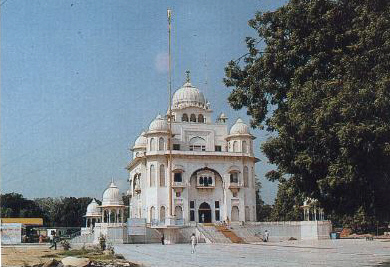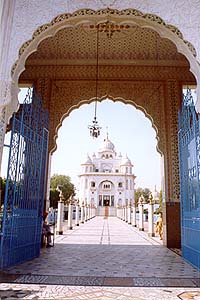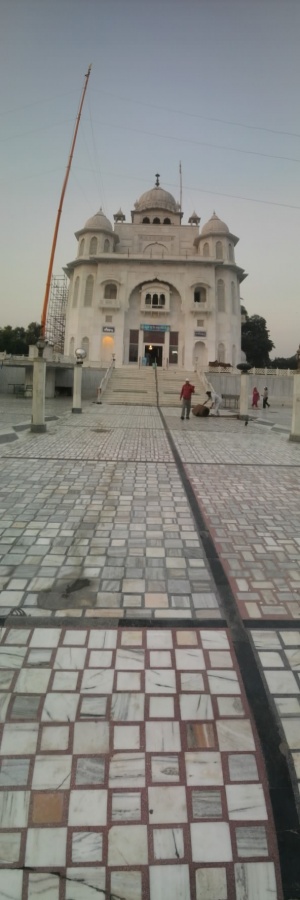The Gurdwara Rakab Ganj Sahib is a historic gurdwara near Parliament House in New Delhi. It was built in 1783, after Sikh military leader Baghel Singh
(1730–1802) captured Delhi, on 11 March 1783, and his brief stay in
Delhi, led to the construction of several Sikh religious shrines within
the city. This one marks the site of cremation of the ninth Sikh Guru, Sri Guru Tegh Bahadur ji, after his martyrdom in November 1675 for saving Hindu Kashmiri Pandits, under orders of Aurangzeb. The Gurudwara sahib is built near old Raisina village near Raisina Hill,
at present Pandit Pant Marg, took 12 years to build. Prior to that, a
mosque had been built near the spot; eventually later Mughal emperor Shah Alam II gave the permission to build a Gurdwara sahib there.
The Gurdwara Rakanganj sahib is also home to the Delhi Sikh Gurdwara Management Committee.

Gurdwara Rakab Ganj Sahib, Delhi
The Delhi Sikh Gurdwara Management Committee is planning to build a memorial to the Sikhs killed during the 1984 Anti-Sikh genocide at the site. Though the foundation stone for the memorial has been laid, the Delhi High Court is considering a petition challenging the construction of the memorial.
SOURCES : SIKH GURUS ,KHALSA PANT OTHERS AND WIKIPEDIA
POSTED BY : VIPUL KOUL ,EDITED BY : ASHOK KOUL

According to historical records Sardar Bhagel Singh, constructed a Gurdwara in village Raisina in 1783 to perpetuate the memory of the ninth Guru Sri Tegh Bahadur. He had conquered Delhi by leading an army of 30,000 Sikh warriors alongwith four other commanders. Earlier, Muslims of Delhi had built a mosque on the spot where the Guru's headless body was cremated. The Sikhs claimed this spot as their own sacred place. Muslims contested this claim, and strongly objected to the dismantling of the Mosque. Rival parties stood with swords drawn and anything could have happened. But the Sikhs offered the Muslims to reconstruct the mosque on their expense in case the urn containing the ashes of the respected Guru was not found buried beneath. Thus tempers cooled down and excavation work commenced in the presence of the Mughal officials.
The assertion of the Sikhs proved to be correct and they were allowed to construct Gurdwara Rakab Ganj by Emperor Shah Alam II. He also granted two Sanads to Sikhs. One sanad granted permission to S. Bhagel Singh to take possession of the land for construction of a Gurdwara and a garden. By second Sanad the Emperor also gifted 101 bighas and '5 biswas pukhta equal to about 63 acres with 3 wells land, revenue free. Sikh forces agreed to withdraw from Delhi territory peacefully after the construction of their religious shrines in the Mughal capital in lieu of these concessions.
Thus Sikhs were able to build a magnificent Gurdwara to keep up the memory of the great Guru who made supreme sacrifice for the freedom of worship, belief and expression. He lived and died for the morally and spiritually civilized future of mankind.
Gurdwara Rakab Ganj stands today on the Pant Road in New Delhi, facing Parliament House and North Block of Central Secretariat. It has the most modern building of white marble surrounded by a beautiful garden.
Like most other Sikh shrines this Gurdwara has entrances from four
sides symbolising that they are open to all without any distinction of
caste and creed. This historical Gurdwara was built at a cost of 25 lakh
rupees and took 12 years to complete.
History is full of tales of martyrs who were first arrested and then executed by the powers, they dared to oppose or resist for a righteous cause, Guru Tegh Bahadur was unique martyr in the sense that the he himself went to Delhi, sacrificed his life in defence of the oppressed, who were helpless before the might of the Mughal empire.
Rakab Ganj Sahib is an important historic Gurdwara in Delhi, India. It’s located at the exact spot where Dhan Sri Guru Tegh Bahadur's headless body was cremated after the Mughal executioner Jalaudin of Samana beheaded the ninth Guru of the Sikhs on November 11, 1675.
In order to awaken the conciousness of the masses and to focus the minds of the nation's elite, the ninth Sikh Guru volunteered to lay down his life so that the atrocities of the cruel Mughal empire could be thrown into the forefront of issues that were deemed important for the country at the time. Consequently, the execution of the Guru in 1675 spelt the beginning of the end of the Mughal empire
Guru ji's body was rescued by these two with a convoy of several ox-driven carts carrying bales of cotton and foodstuffs. Due to the strong dust storm, these brave Sikhs managed to lift the body of the Guru without the Mughal guards discovering what was going on.
These two Sikhs were able to lift the body with great speed under the cover of the storm and then conceal the body in the cart under bales of cotton. They then quickly moved towards Raisina village, the place where they lived. On reaching their abode they were able to avoid any suspicion by the authorities since Bhai Lakhi Shah Banjara placed the body on a bed and set fire to his whole house.
This place came to be known as Rakab Ganj. This tragic death of the Guru and his dedicated companions took place on November 11, 1675 under orders of the Mughal Emperor Aurangzeb. Another devoted Sikh, Bhai Jaita took the Guru ji's head to Anandpur Sahib, 500Km (300 miles) away from Sis Ganj, Chandni Chowk.
See Martyrdom of Guru Tegh Bahadur Sahib for further details.
The present location of the magnificent Gurdwara is on the Pant Road
in New Delhi, facing Parliament House and North Block of Central
Secretariat. The modern building is composed mainly of white marble
surrounded by a beautiful garden. Like most other Sikh shrines this
Gurdwara has entrances from four sides symbolising that they are open to
all without any distinction of caste or creed. This historical Gurdwara
was built at a cost of 25 lakh rupees and took 12 years to complete.
Rival parties stood with swords drawn and the atmosphere was tense - anything could have happened. However, the Sikhs offered to reconstruct the mosque for the Muslims with their own expense in case the urn containing the ashes of the respected Guru was not found buried beneath the Mosque that stood there. This helped calm the atmosphere and tempers cooled down. The excavation work commenced in the presence of the Mughal officials.
The assertion made by the Sikhs proved to be correct and they were allowed to construct Gurdwara Rakab Ganj by Emperor Shah Alam II. He also granted two Sanads to Sikhs. One Sanad granted permission to S. Bhagel Singh to take possession of the land for construction of a Gurdwara and a garden. By the second Sanad, the Emperor also gifted 101 bighas and 5 biswas pukhta equal to about 63 acres with 3 wells land, revenue free. Sikh forces agreed to withdraw from Delhi territory peacefully after the construction of their religious shrines in the Mughal capital in lieu of these concessions.
The Gurdwara Rakanganj sahib is also home to the Delhi Sikh Gurdwara Management Committee.

History
The Gurdwara marks the site, where Lakhi Shah Banjara and his son Bhai Naghaiya burnt their own house to cremate the body of the Sikh Guru Guru Tegh Bahadur sahib who, on 11 November 1675, was martyred by beheading at Chandni Chowk on the orders of the Mughal emperor Aurangzeb for refusing to convert to Islam. The spot where the Guru sahib were beheaded is marked by Gurdwara Sis Ganj Sahib. The Guru sahib's severed head was brought from Delhi to Anandpur Sahib in Punjab by Bhai Jaita ji (later Bhai Jiwan Singh) and was cremated by his son, Guru Gobind Rai, who later became Guru Gobind Singh, the tenth Guru of the Sikhs.The Delhi Sikh Gurdwara Management Committee is planning to build a memorial to the Sikhs killed during the 1984 Anti-Sikh genocide at the site. Though the foundation stone for the memorial has been laid, the Delhi High Court is considering a petition challenging the construction of the memorial.
SOURCES : SIKH GURUS ,KHALSA PANT OTHERS AND WIKIPEDIA
POSTED BY : VIPUL KOUL ,EDITED BY : ASHOK KOUL

On
the fateful day a sword of executioner Jalaudin of Samana, struck with a
thud. The head of Guru Tegh Bahadur was cut off and people cried in
utter helplessness. This tragedy took place on November 11, 1675, in
Chandni Chowk, Delhi under orders of Emperor Aurangzeb. The.sky was
overcast with dark clouds and a terrible duststorm followed. In the
midst of invisibilty caused by duststorm,a disciple of the Guru took
away the head of the great martyr, and ran away to a place of safety.
Covering a 500 km journey with courage and fortitude, he managed to
reach Anandpur Sahib in Punjab along with the holy head of his spiritual
preceptor and placed it before Guru Gobind Singh This devoted Sikh was
none else but Bhai Jaita a Rengreta Sikh. The tenth Guru embraced him
and remarked 'Rengreta Guru Ka beta'. So the head of the Guru was cremated at Anandpur Sahib with proper ceremony.
Another
act of valour and dedication, was performed by Bhai Lakhi Shah Banjara
and his son, Bhai Naghaiya. They reached Chandni Chowk after the
execution of the Guru with a convoy of ox-driven carts carrying bales of
cotton and foodstuffs. They lifted the headless body of the Guru with
flash speed and alacrity and placed it in the cart under the cotton
bales. They pushed away briskly towards Raisina village, the place of
their habitat. No alarm was raised by the guards as the dust storm
was raging and nothing was visible. They were hiding in a
safer place to save themselves from the fury of natural
elements and defiant men. To avoid any suspicion by the
authorities Bhai Lakhi Banjara placed the body on a bed and set
fire to the whole house This place came to be known as Rakab Ganj,
because most of the residents of Raisina village used to
manufacture straps for the cavalry of Mughal Army. How they
managed to bring the headless body of the Guru safely to
their house was a miracle. Bhai Lakhi Banjara and his sons
were successful in their mission of bringing the headless
body of the Guru to their village, notwithstanding the search which
was instituted immediately after by the imperial police when they
found the body of the Guru missing. But the devotees of the
Guru had already cremated the holy body by burning their own
house. After the cremation of the body the ashes were put in a
gagar(urn) and buried on the spot. For general public it was
a miracle as Guru's.dead body could not be found, out by the
police despite serious efforts. Bhai Lakhi Shah Banjara and
his sons by putting themselves in such evident danger
performed an exemplary act of religious devotion and thereby
earned gratitude of the Sikhs for all times to come.
According to historical records Sardar Bhagel Singh, constructed a Gurdwara in village Raisina in 1783 to perpetuate the memory of the ninth Guru Sri Tegh Bahadur. He had conquered Delhi by leading an army of 30,000 Sikh warriors alongwith four other commanders. Earlier, Muslims of Delhi had built a mosque on the spot where the Guru's headless body was cremated. The Sikhs claimed this spot as their own sacred place. Muslims contested this claim, and strongly objected to the dismantling of the Mosque. Rival parties stood with swords drawn and anything could have happened. But the Sikhs offered the Muslims to reconstruct the mosque on their expense in case the urn containing the ashes of the respected Guru was not found buried beneath. Thus tempers cooled down and excavation work commenced in the presence of the Mughal officials.

The assertion of the Sikhs proved to be correct and they were allowed to construct Gurdwara Rakab Ganj by Emperor Shah Alam II. He also granted two Sanads to Sikhs. One sanad granted permission to S. Bhagel Singh to take possession of the land for construction of a Gurdwara and a garden. By second Sanad the Emperor also gifted 101 bighas and '5 biswas pukhta equal to about 63 acres with 3 wells land, revenue free. Sikh forces agreed to withdraw from Delhi territory peacefully after the construction of their religious shrines in the Mughal capital in lieu of these concessions.
Thus Sikhs were able to build a magnificent Gurdwara to keep up the memory of the great Guru who made supreme sacrifice for the freedom of worship, belief and expression. He lived and died for the morally and spiritually civilized future of mankind.
Gurdwara Rakab Ganj stands today on the Pant Road in New Delhi, facing Parliament House and North Block of Central Secretariat. It has the most modern building of white marble surrounded by a beautiful garden.
History is full of tales of martyrs who were first arrested and then executed by the powers, they dared to oppose or resist for a righteous cause, Guru Tegh Bahadur was unique martyr in the sense that the he himself went to Delhi, sacrificed his life in defence of the oppressed, who were helpless before the might of the Mughal empire.
Rakab Ganj Sahib is an important historic Gurdwara in Delhi, India. It’s located at the exact spot where Dhan Sri Guru Tegh Bahadur's headless body was cremated after the Mughal executioner Jalaudin of Samana beheaded the ninth Guru of the Sikhs on November 11, 1675.
In order to awaken the conciousness of the masses and to focus the minds of the nation's elite, the ninth Sikh Guru volunteered to lay down his life so that the atrocities of the cruel Mughal empire could be thrown into the forefront of issues that were deemed important for the country at the time. Consequently, the execution of the Guru in 1675 spelt the beginning of the end of the Mughal empire
Background
Two brave Sikhs of the Guru, Bhai Lakhi Shah Banjara and his son, Bhai Naghaiya rescued the headless body of the revered ninth Sikh Guru from Chandni Chowk, Delhi after the execution of the Guru.Guru ji's body was rescued by these two with a convoy of several ox-driven carts carrying bales of cotton and foodstuffs. Due to the strong dust storm, these brave Sikhs managed to lift the body of the Guru without the Mughal guards discovering what was going on.
These two Sikhs were able to lift the body with great speed under the cover of the storm and then conceal the body in the cart under bales of cotton. They then quickly moved towards Raisina village, the place where they lived. On reaching their abode they were able to avoid any suspicion by the authorities since Bhai Lakhi Shah Banjara placed the body on a bed and set fire to his whole house.
This place came to be known as Rakab Ganj. This tragic death of the Guru and his dedicated companions took place on November 11, 1675 under orders of the Mughal Emperor Aurangzeb. Another devoted Sikh, Bhai Jaita took the Guru ji's head to Anandpur Sahib, 500Km (300 miles) away from Sis Ganj, Chandni Chowk.
See Martyrdom of Guru Tegh Bahadur Sahib for further details.
Modern Building
Panoramic view - front
Historic Account
Historical records show that Sardar Baghel Singh, constructed a Gurdwara in village Raisina in 1783 to perpetuate the memory of the ninth Guru Sri Tegh Bahadur. He had conquered Delhi by leading an army of 30,000 Sikh warriors along with four other commanders. Before 1783, the Muslims of Delhi had built a mosque on this very spot. The Sikhs claimed this spot as their own sacred place in memory of the sacrifice to their Guru. Muslims contested the claim, and there was strong objection to the dismantling of the Mosque.Rival parties stood with swords drawn and the atmosphere was tense - anything could have happened. However, the Sikhs offered to reconstruct the mosque for the Muslims with their own expense in case the urn containing the ashes of the respected Guru was not found buried beneath the Mosque that stood there. This helped calm the atmosphere and tempers cooled down. The excavation work commenced in the presence of the Mughal officials.
The assertion made by the Sikhs proved to be correct and they were allowed to construct Gurdwara Rakab Ganj by Emperor Shah Alam II. He also granted two Sanads to Sikhs. One Sanad granted permission to S. Bhagel Singh to take possession of the land for construction of a Gurdwara and a garden. By the second Sanad, the Emperor also gifted 101 bighas and 5 biswas pukhta equal to about 63 acres with 3 wells land, revenue free. Sikh forces agreed to withdraw from Delhi territory peacefully after the construction of their religious shrines in the Mughal capital in lieu of these concessions.



No comments:
Post a Comment